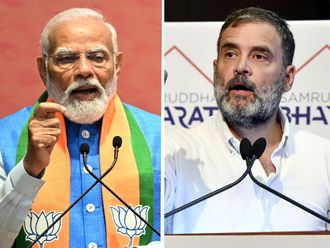Bodh Gaya: Two monks were injured on Sunday when nine bombs went off in quick succession at the revered Mahabodhi temple complex in Bihar’s Bodh Gaya town where the Buddha attained enlightenment.
Prime Minister Manmohan Singh said “such attacks on religious places will never be tolerated”, while President Pranab Mukherjee termed the serial blasts a “senseless act of violence”. The terror strike also triggered an ugly political spat in the state.
Nine blasts took place between 5.30am and 6am at the 1,500-year-old Mahabodhi temple, annually visited by millions of pilgrims from all over the world. The deafening explosions triggered panic, but caused no major damage. An official had earlier said that there were eight bombings.
The blasts made the hotels, where a number of tourists were staying, shake, said a local who resides near the Mahabodhi temple.
“All the people, foreigners and tourists, came out wondering what had happened,” said the local resident.
The temple complex, which is a Unesco Heritage site, has direct association with the Buddha (566-486 BC) as it was the place where he attained enlightenment in 531 BC while seated under the Bodhi tree. Bodh Gaya is about 110km from Patna.
Home Minister Sushilkumar Shinde said four of nine bombs went off in the temple complex, three in a monastery nearby, one near the statue of the Buddha, and another near a tourist bus.
Bihar Police chief Abhayanand said the blasts were not of “very high intensity” and therefore no damage was caused to the sanctum sanctorum.
“The evening prayers by monks will take place but general public would not be allowed inside the premises as of now,” he said.
Union Home Secretary Anil Goswami also confirmed the temple complex had not suffered any damage. “The monastery and the statue of Lord Buddha are safe.”
Additional director general of Police S.K. Bhardwaj said two Buddhist monks were injured — one a Tibetan and the other a Myanmarese national.
“[The] injured Tibetan is identified as Tenzing Dorjee, 50, and the injured Myanmarese is Vilas Ga, 30,” Bhardwaj said.
Union Minister of State for Home R.P.N. Singh termed it a terror attack, while strategic analyst C. Uday Bhaskar said there was “little doubt that as per the classical evaluation of terror attacks — the multiple blasts at Bodh Gaya will qualify as a definitive terror attack”.
Uday Bhaskar said there was some reference to intelligence inputs from Myanmar, about the likelihood of such an attack.
The terror strike triggered a political row between the Bharatiya Janata Party and the Janata Dal-United, which broke their 17-year-old alliance barely a fortnight ago.
“The state government had been told about recces that had been conducted by terror elements of the place, especially in context of the violence in Myanmar,” said BJP spokesperson Ravi Shankar Prasad, referring to the violence in Myanmar where scores of people have been killed in unrest between Buddhists and Muslims in Rakhine state.
“There were warnings, but no preventive action was taken...Why?” he asked.
Chief Minister Nitish Kumar was, however, quick to refute allegations about his government having ignored intelligence inputs.
“There are CCTV cameras at the Mahabodhi temple... We have had a close look at the security of the temple earlier too... But the way these people entered and even became successful to plant bombs, we have to analyse in what dress they entered the temple and even examine the security at the gates,” the chief minister told reporters after visiting Bodh Gaya.
The National Investigation Agency (NIA) would conduct a probe into the blasts, he added.
Intelligence agencies had last month warned the district authorities about a security threat to the temple.
A Delhi Police team is also likely to visit Bodh Gaya to share information provided by the arrested Indian Mujahideen terrorists, who had earlier planned an attack on the temple, police said.
A senior Delhi Police official said they had alerted intelligence agencies and Bihar Police about a likely terror attack in the state.
The Mahabodhi temple is one of the few surviving examples of early brick structures in India and has had significant influence in the development of architecture over the centuries.
Unesco describes it as one of the earliest and most imposing structures built entirely from brick in the late Gupta period.












